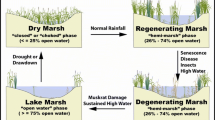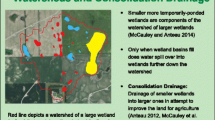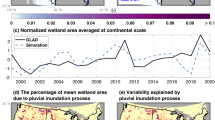Abstract
Potential impacts of climate change on the position of the wetland-hydrology boundary were estimated for four sites in the Eastern U.S. Precipitation and temperature predictions were obtained from the Hadley general circulation model (UKMO-HadCM3) because it most closely approximated observed precipitation for the period 1950–2000. The DRAINMOD hydrologic model was used to compute daily water table levels over two time periods: 1983–2012 (current conditions) and 2041–2070 (future conditions). For each site and time period, the model simulated water table depths for a soil pedon (Typic Paleaquult) that previous work demonstrated was on the wetland-hydrology boundary. Results for the Pitt County site in NC showed that by 2070 the wetland-hydrology boundary would have moved “downhill” to a point that was approximately 17 cm lower in elevation than where the boundary was in 2012 due to a 20% increase in evapotranspiration. Similar analyses were done for hypothetical wetland soils in Miami FL, Easton MD, and Portland ME where the wetland hydrology boundaries were estimated to drop in elevation by 5, 10 and 25 cm, respectively. Our results demonstrated that climate change may have significant impact on wetland boundaries.








Similar content being viewed by others
References
Ainsworth EA, Rogers A (2007) The response of photosynthesis and stomatal conductance to rising [CO2]: mechanisms and environmental interactions. Plant, Cell & Environment 30:258–270
Amataya DM, Sun G, Skaggs RW, Chescheir GM, and Nettles JE (2006) Hydrologic effects of global climate change on a large drained pine forest. In Hydrology and Management of Forested Wetlands, proceedings of the international conference 8–12 April 2006. American Society of Agricultural and Biological Engineers Publication No. 701P0406
Caldwell PV, Vepraskas MJ, Skaggs RW, Gregory JD (2007) Simulating the hydrology of natural Carolina Bay wetlands. Wetlands 27(4):1112–1123
Cao L, Bala G, Caldeira K, Nemani R, Ban-Weiss G (2010) Importance of carbon dioxide physiological forcing to future climate change. PNAS 107(21):9513–9518
Daniels, RB, Buol SW, Kleiss HJ, Ditzler CA (1999) Soil systems in North Carolina. Technical Bulletin number 314, North Carolina Agricultural Research Service, Raleigh North Carolina
Delworth TL, Broccoli AJ, Rosati A, Stouffer RJ, Balaji V, Beesley JA, Cooke WF, Dixon KW, Dunne J, Dunne KA, Durachta JW, Findell KL, Ginoux P, Gnanadesikan A, Gordon CT, Griffies SM, Gudgel R, Harrison MJ, Held IM, Hemler RS, Horowitz LW, Klein SA, Knutson TR, Kushner PJ, Langenhorst AR, Lee H-C, Lin S-J, Lu J, Malyshev SL, Milly PCD, Ramaswamy V, Russell J, Schwarzkopf MD, Shevliakova E, Sirutis JJ, Spelman MJ, Stern WF, Winton M, Wittenberg AT, Wyman B, Zeng F, Zhang R (2006) GFDL's CM2 global coupled climate models. Part I: formulation and simulation characteristics. Journal of Climate 19(5):643–674
Environmental Laboratory (1987) U.S. Army Corps of Engineers wetlands delineation manual. Technical Report Y-87-1, U.S. Army Engineer Waterways Experiment Station, Vicksburg, MS
Erwin KL (2009) Wetlands and global climate change: the role of wetland restoration in a changing world. Wetlands Ecology and Management 17:71–84
Federal Register (1994) Changes in hydric soils of the United States. U.S. Government Printing Office, Washington, DC
Flato GM, Boer GJ (2001) Warming asymmetry in climate change simulations. Geophysical Research Letters 28(1):195–198
Flato GM, Hibler WD (1992) Modeling pack ice as a cavitating fluid. Journal of Physical Oceanography 22(6):626–651
Gnanadesikan A, Dixon KW, Griffies SM, Balaji V, Barreiro M, Beesley JA, Cooke WF, Delworth TL, Gerdes R, Harrison MJ, Held IM, Hurlin WJ, Lee HC, Liang Z, Nong G, Pacanowski RC, Rosati A, Russell J, Samuels BL, Song Q, Spelman MJ, Stouffer RJ, Sweeney CO, Vecchi G, Winton M, Wittenberg AT, Zeng F, Zhang R, Dunne JP (2006) GFDL's CM2 global coupled climate models. Part II: the baseline ocean simulation. Journal of Climate 19(5):675–697
Gordon C, Cooper C, Senior CA, Banks H, Gregory JM, Johns TC, Mitchell JFB, Wood RA (2000) The simulation of SST, sea ice extents and ocean heat transports in a version of the Hadley Centre coupled model without flux adjustments. Climate Dynamics 16(2-3):147–168.
Hayes WA, Vepraskas MJ (2000) Morphological changes in soils produced when hydrology is altered by ditching. Soil Science Society of America Journal 64:1893–1904
He X, Vepraskas MJ, Skaggs RW, Lindbo DL (2002) Adapting a drainage model to simulate water table levels in coastal plain soils. Soil Science Society of America Journal 66:1722–1731
He X, Vepraskas MJ, Lindbo DL, Skaggs RW (2003) A method to predict soil saturation frequency and duration from soil color. Soil Science Society of America Journal 67:961–969
Hooghoudt SB (1940) Bijdrage tot de kennis van eenige natuurkundige grootheden van den grond No. 7. Algemeene beschouwingen van het probleem van de detailontwatering en de infiltratie door middel van parallel loopende drains, greppels, slooten en kanalen. Departement van Landbouw en Visscherij, Directie van de Landbouw. Algemeene Staatsdrukkerij, The Hague, The Netherlands. Verslagen van Landbouwkundige Onderzoekingen, No. 46(14): 515–707 (in Dutch)
Hopkinson CS et al (2013) The effects of climate change on natural ecosystems of the Southeast USA. In: Ingram KT, Dow K, Carter L, Anderson J (eds) Climate of the Southeast United States: variability, change, impacts, and vulnerability. Island Press, Washington DC
Intergovernmental Panel on Climate Change (2013) Climate change 2013: the physical science basis. Contribution of working group I to the fifth assessment report of the intergovernmental panel on climate change Cambridge University Press, Cambridge, United Kingdom and New York, NY, USA
Johnson WC, Werner B, Guntenspergen GR, Voldseth RA, Millett B, Naugle DE, Tulbure M, Carroll RWH, Tracy J, Olawsky C (2010) Prairie wetland complexes as landscape functional units in a changing climate. BioScience 60(2):128–140
Kim SJ, Flato GM, Boer GJ, McFarlane NA (2002) A coupled climate model simulation of the last glacial maximum, part 1: transient multi-decadal response. Climate Dynamics 19(5–6):515–537
Kim SJ, Flato GM, Boer GJ (2003) A coupled climate model simulation of the last glacial maximum, part 2: approach to equilibrium. Climate Dynamics 20(6):635–661
Leakey ADB, Ainsworth EA, Bernacchi CJ, Rogers A, Long SP, Ort DR (2009) Elevated CO2 effects on plant carbon, nitrogen, and water relations: six important lessons from FACE. Journal of Experimental Botany 60(10):2859–2876
Maurer E, Brekke L, Pruit T, Duffy P (2007) Fine-resolution climate projections enhance regional climate change impact studies. Transactions of the American Geophysical Union 88(47):504
McDonald MG, Harbaugh AW (1988) A modular three-dimensional finite-difference ground-water flow model. U.S. Geological Survey, Techniques of Water-Resources Investigations 06-A1, Book 6, U.S. Geological Survey, Denver, CO
Meehl G et al (2007) The WCRP CMIP3 multi-model dataset: a new era in climate change research. Bulletin of the American Meteorological Society 88:1383–1394
Monteith JL (1965) Evaporation and the environment. Symposia of the Society for Experimental Biology 19:205–234
Mpelasoka FS, Chiew FHS (2009) Influence of rainfall scenario construction methods on runoff projections. Journal of Hydrometeorology 10:1168–1183
Pope VD, Gallani ML, Rowntree PR, Stratton RA (2000) The impact of new physical parametrizations in the Hadley Centre climate model: HadAM3. Climate Dynamics 16(2–3):123–146
Skaggs RW (1978) A water management model for shallow water table soils. Technical Report 134, University of North Carolina Water Resources Research Institute, Raleigh NC
Skaggs RW (1982) Field evaluation of a water management simulation model. Transactions of the American Society of Agricultural Engineers 25(3):666–674
Skaggs RW, Amatya D, Evans RO, Parsons JE (1994) Characterization and evaluation of proposed hydrologic criteria for wetlands. Journal of Soil and Water Conservation 49(5):501–510
Skaggs RW, Chescheir GM, Phillips BD (2005) Methods to determine lateral effect of a drainage ditch on wetland hydrology. Transactions of the American Society of Agricultural Engineers 48(2):577–584
Stouffer RJ, Broccoli AJ, Delworth TL, Dixon KW, Gudgel R, Held I, Hemler R, Knutson T, Lee HC, Schwarzkopf MD, Soden B, Spelman MJ, Winton M, Zeng F (2006) GFDL's CM2 global coupled climate models. Part IV: idealized climate response. Journal of Climate 19(5):723–740
Thornthwaite CW (1948) An approach toward a rational classification of climate. Geographical Review 38:55–94
Trenberth KE et al (2007) Observations: surface and atmospheric climate change. In: Solomon S, Qin D, Manning M, Chen Z, Marquis M, Averyt K, Tignor M, Miller H (eds) Climate change 2007: the physical science basis. Contribution of working group I to the fourth assessment report of the intergovernmental panel on climate change. Cambridge University Press, New York
U.S. Army Corps of Engineers (2005) Technical standard for water-table monitoring of potential wetland sites. WRAP Technical Notes Collection, ERDC TN-WRAP-05-2. U.S. Army Engineer Research and Development Center, Vicksburg MS
U.S. Army Corps of Engineers (2010) Regional Supplement to the Corps of Engineers Wetland Delineation Manual: Atlantic and Gulf Coastal Plain Region (Version 2.0), Wakeley JS, Lichvar RW, Noble CV (eds) ERDC/EL TR-10-20, U.S. Army Engineer Research and Development Center, Vicksburg MS
U.S. Department of Agriculture, Natural Resources Conservation Service (2010) Field indicators of hydric soils in the United States. Ver. 7.0, Vasilas LM, Hurt GW, Noble CV (eds.) USDA, NRCS in cooperation with the National Technical Committee for Hydric Soils
U.S. Department of Agriculture, Natural Resources Conservation Service (2019) Wetlands (WETS) climate tables. USDA, NRCS, National Water and Climate Center. Available via www.wcc.nrcs.usda.gov/climate/wets_doc.html. Accessed 3 May 2019
U.S. Environmental Protection Agency (2013) Watershed modeling to assess the sensitivity of streamflow, nutrient, and sediment loads to potential climate change and urban development in 20 U.S. watersheds. National Technical Information Service, Washington DC
Vose JM, Klepzig KD (2013) Climate Change Adaptation and Mitigation Management Options: A Guide for Natural Resource Managers in Southern Forest Ecosystems. CRC Press, Boca Raton
Wear DN, Greis JG (2013) The southern forest futures project: technical report. General Technical Report SRS-GTR-178. USDA-Forest Service, Southern Research Station, Asheville
Wittenberg AT, Rosati A, Lau NC, Ploshay JJ (2006) GFDL's CM2 global coupled climate models. Part III: tropical Pacific climate and ENSO. Journal of Climate 19(5):698–722
Wood RA, Keen AB, Mitchell JFB, Gregory JM (1999) Changing spatial structure of the thermohaline circulation in response to atmospheric CO2 forcing in a climate model. Nature 399(6736):572–575
Zhang Y, Li W, Sun G, Miao G, Noormets A, King J (2018) Understanding coastal wetland hydrology with a new regional-scale, process-based hydrological model. Hydrological Processes 32:3158–3173
Zhu J, Sun G, Li W, Zhang Y, Miao G, Noormets A, McNulty SG, King JS, Kumar M, Wang X (2017) Modeling the potential impacts of climate change on the water table level of selected forested wetlands in the southeastern United States. Hydrology and Earth System Sciences 21:6289–6305
Acknowledgements
We gratefully acknowledge the help of USDA Natural Resources Conservation Service who supplied partial funding for this research under contract no. 68-7482-11-549.
Author information
Authors and Affiliations
Corresponding author
Additional information
Publisher’s Note
Springer Nature remains neutral with regard to jurisdictional claims in published maps and institutional affiliations.
Rights and permissions
About this article
Cite this article
Vepraskas, M.J., Skaggs, R.W. & Caldwell, P.V. Method to Assess Climate Change Impacts on Hydrologic Boundaries of Individual Wetlands. Wetlands 40, 365–376 (2020). https://doi.org/10.1007/s13157-019-01183-6
Received:
Accepted:
Published:
Issue Date:
DOI: https://doi.org/10.1007/s13157-019-01183-6




